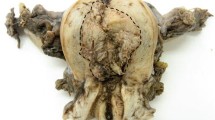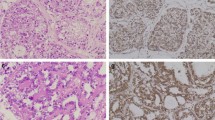Summary
A new epithelial cell line derived from undifferentiated carcinoma of human renal pelvis, designated KP 1, was established in vitro. The cell line has been passaged 190 times in vitro for 5 years and 9 months. The predominant cell in KP1 was a tear-drop-shaped cell. Doubling time of the cell line was 35 h. The malignant epithelial character of this line was verified by carcinogenictiy in the subcuticular layer of nude mice and by karyotypic analysis which revealed the cells to be completely aneuploid with a model chromosome number in the hypertriploid range. KP 1 cells were shown to produce both tissue thromboplastin and plasminogen activator which was immunologically identical to urokinase, the plasminogen activator in urine.
Similar content being viewed by others
References
Åstedt B, Holmberg L (1976) Immunological identity of urokinase and ovarian carcinoma plasminogen activator released in tissue culture. Nature 261:595
Astrup T (1965) Assay and content of tissue thromboplastin in different organs. Thromb Diath Haemorrh 14:401
Barnhart MI, Forman WB (1955) Purification of fibrinogen. In: Tocantins LM, Kazal LA (eds) Blood coagulation, hemorrhage and thrombosis. Grune and Stratton, New York London, p 230
Davis RB, Theologides A, Kennedy BJ (1969) Comparative studies of blood coagulation and platelet aggregation in patients with cancer and non-malignant diseases. Ann Intern Med 71:67
Deutsh DG, Mertz ET (1970) Plasminogen: purification from human plasma by affinity chromatography. Science 170:1095
Elliott AY, Bronson DL, Stein N, Fraley EE (1976) In vitro cultivation of epithelial cells derived from tumors of human urinary tract. Cancer Res 36:365
Hisazumi H, Andersson L, Collins VP (1977) Fibrinolytic activity of in vitro cultivated human bladder cell lines. Urol Res 5:133
Kinjo M (1978) Lodgement and extravasation of tumor cells in blood-borne metastasis: an electron microscope study. Br J Cancer 38:293
Kinjo M, Oka K, Naito S, Kohga S, Tanaka K, Oboshi S, Hayata Y, Yasumoto K (1979) Thromboplastic and fibrinolytic activities of cultured human cancer cell lines. Br J Cancer 39:15
Kohga S (1978) Thromboplastic and fibrinolytic activities of ascites tumor cells of rats, with reference to their role in metastasis formation. Gan 69:461
Lieberman JS, Borrero J, Urdaneta E, Wright IS (1961) Thrombophlebitis and cancer. JAMA 177:542
Miller SP, Sanchez-Alvalos J, Stetanski T, Zuckerman L (1967) Coagulation disorders in cancer. I. Clinical and laboratory studies. Cancer 20:1452
Naito S, Sueishi K, Hattori F, Tanaka K (1980) Immunological analysis of plasminogen activators from cultured human cancer cells. Virchows Arch (Pathol Anat) 387:251
Naito S, Tanaka K, Kanamori T, Hisano S, Momose S, Emoto K (1980) Heterotransplantation of human upper urinary tract tumors in nude mice. Invest Urol 17:522
O'Meara RAQ (1958) Coagulative properties of cancers. Ir J Med Sci 394:474
O'Meara RAQ (1968) Fibrin formation and tumor growth. Thromb Diath Haemorrh [Suppl] 28:137
Peck SD, Reiquam CW (1973) Disseminated intravascular coagulation in cancer patients: Supportive evidence. Cancer 31:1114
Peterson HI (1968) Experimental studies on fibrinolyisis in growth and spread of tumour. Acta Chir Scand [Suppl] 394:1
Rohner RF, Prior JT, Sipple JH (1966) Mucinous malignancies, venous thrombosis and terminal endocarditis with emboli. A syndrome. Cancer 19:1805
Tanaka K, Kohga S, Kinjo M, Kodama Y (1977) Tumor metastasis and thrombosis, with special reference to thromboplastic and fibrinolytic activities of tumor cells. In: Stansly PG, Sato H (eds) GANN Monograph on cancer research, No. 20. University of Tokyo Press, Tokyo, p 97
Tucker WS, Kirsch WM, Matinez-Hernandez A, Fink LM (1978) In vitro plasminogen activator activity in human brain tumors. Cancer Res 38:297
Warren BA, Vales O (1972) The adhesion of thromboplastic tumour emboli to vessel walls in vivo. Br J Exp Pathol 53:301
Yajima T (1968) Monolayer culture of human urinary bladder tumors. Nippon Hinyokika Gakkai Zasshi 59:128
Yajima T (1970) Monolayer culture of human urinary bladder tumors. Nippon Hinyokika Gakkai Zasshi 61:805
Author information
Authors and Affiliations
Rights and permissions
About this article
Cite this article
Naito, S., Tanaka, K., Kanamori, T. et al. Establishment of a human renal pelvic cancer cell line producing tissue thromboplastin and plasminogen activator. Urol. Res. 10, 19–25 (1982). https://doi.org/10.1007/BF00256519
Accepted:
Issue Date:
DOI: https://doi.org/10.1007/BF00256519




